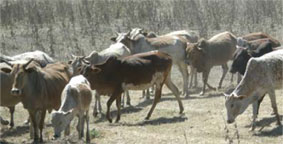Communicable Diseases Module: 38. Common Zoonotic Diseases in Ethiopia: Rabies and Taeniasis
Study Session 38 Common Zoonotic Diseases in Ethiopia: Rabies and Taeniasis
Introduction
In the last two study sessions in this Module, you learned about vector-borne diseases in which the infectious agent is transmitted to new human hosts by body lice, flying insects or snails. In this study session, we turn to two communicable diseases found in Ethiopia in which a non-human warm-blooded animal transmits the infectious agent to humans. These diseases are rabies transmitted to humans by dogs, and taeniasis (or tapeworm disease) transmitted by cows. Diseases in which a warm-blooded animal transmits the infectious agents to humans are known as zoonotic diseases (or zoonoses).
Taeniasis is pronounced ‘teen-eye-assis’. Zoonotic is pronounced ‘zoo-nott-ik’.
Zoonotic diseases are difficult to control because the non-human animal acts as a reservoir of infection that can be passed on to humans. Dogs and cows are domestic species, living in large numbers in human settlements (Figure 38.1), where it is very easy for the infection to be transmitted to people. In this study session, you will learn about the causes, modes of transmission, clinical manifestations, and the prevention and control measures against these two zoonotic diseases – rabies and taeniasis.

